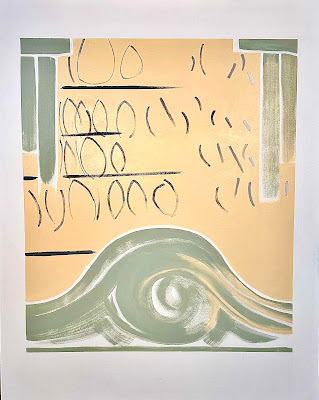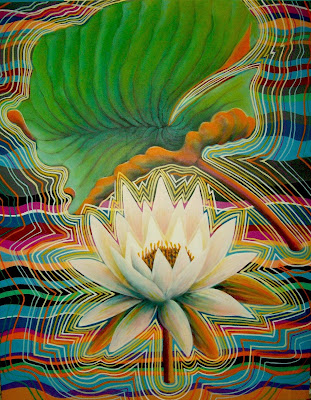Today, ‘round here, folks want their yoga burnin’ hot and hard. They look up to the possibility of standing on their heads. And they admire those capable of getting revolved and twisted to level 2 or even to the rubbery knot of Marichyasana “C.”
Workin’ hard, being pushed, it is a work-out. Why?…With work and family, time in the day is tight. There’s a need for an hour of fitness that modern yoga offers as a strong option that many come to really enjoy to sort of burn off the work day.
To “feel the pain leaving your body” (but unfortunately persistently leaving your body in session after session) is the thing to be after to improve. A few participants even chase the reward of new stickers for their mat for achievements in poses where that is offered. It’s hard not to look around the practice space—whether beginning or advanced—and not judge or not imagine being judged and likely assessing your tier in the hierarchy. Your attainment is flex and balance and strength, and that is a good thing. Your physical ‘feel-good’ is especially experienced post-practice endorphins and brief recovery as in running or fitness training in general. Not bad things.
This post is not a criticism. It is an observation. Contemporary yoga can be viewed positively as vibrant.
I can very roughly sketch my experience with health and fitness from 1950 on:
In the 1950’s, health, and one might even say ‘fitness’ and ‘health’ was a Chesterfield cig for relaxation after a hard days work that “90 percent of doctors recommend” or lard to make you soft. There was next to no jogging except for a few ‘eccentrics.’ The only way one ran on roads was in warm up for track season and no longer after that the start of the season. Gyms were for BB, volleyball, free weights, and a swim—no exercise classes, and more for sport ‘gym rats,’ where I hung out and was employed in the YMCA system fro high school on.
‘Fitness’ appeared in the 1970s. Jogging, 10ks, A few weight machines with multiple stations.
By the 1980’s, independent weight machines were solidly present in heretofore tradtional gyms and new fitness centers. In the 1990s, centers expanded to include exercise rooms’ were added wherein ‘fitness classes’ were developed stressed aerobic conditioning. ‘Spinning’ on indoor exercise bikes being added as ‘fitness’ was also shifting to more intense forms to generate anaerobic—energy without oxygen—for high-intensity bursts.
In the 2000s, there was a minor, rare shift to ‘body mind’ and nutrition with kitchens being added to ‘fitness centers’ in rare cases as new facilities were being built. Fitness instructors began to be ‘certed’ with training in 100-400 hour yoga certification training. Importantly , note that the volume of carted teachers were fitness instructors.
Currently, in the 2020s, yoga gradually emphasized more physicality—hot and increasingly intense. Yoga practice with emphases upon aspects such as nutrition and spirituality were off-putting, and not interest in high-volume practices where teaching becomes a business with costly overhead and primarily emphasize an stability, strength and aerobic practice as an alternative option to traditional fitness and more advanced fitness training.
When I began yoga, it was essentially vinyasa flow through sequences of poses that were either directly or closely related to Astanga style. After a time, I asked my chosen primary teacher about yoga that produced a deeper psycho-spiritual experience. She mentioned restorative yoga and yin yoga as a possibilities to explore. Restorative yoga seemed restful and supportive. While biased presumptions, restorative yoga was viewed by ‘fitness yogis’ as yoga for beginners or ‘seniors’ who essentially ‘could not do ‘real’ yoga, or as a drop-in from time-to-time chill out for recovery. Attending yin yoga, sessions were longer and used fewer poses that we held much longer, and typically, but not always, favored largely floor poses that were difficult such as “dragonfly” or “forward bend” as one tried to deepen the poses rather than shift poses frequently. There were differences between common yoga and yin poses, with a pose like “‘frog” being different than the “frog” of vinyasa approaches.
Across time, I developed a heretofore unknown “restorative-yin yoga” which seemed to be for too an oxymoron that represented relaxation-tension. But releasing and following the body in largely floor poses, emphasizing flowing rather than forcing the body provoked a different kind of neurochemistry and a way to kindly increase flexibility…and more, a sense of poses being islands of grace that evoke feeling of peace and a participant reported, “a feeling of eloquence.”. There are rich moments in the most intense yoga practice, yet quite different in restorative-yin yoga that is calm with room for contemplation rather than pressure.
With the practice of restorative-yin being slower, calmer and pain-free, the experience of characteristics that are identified for ‘spiritual persons’ begin to appear in the practice. Search characteristics of spiritual persons and find that these are often not found in religious orientations that tend to be exclusive rather than inclusive as well as being dogmatic. This ‘spirituality’ was more like a natural state It was like the state of natural, narrow inner bio-physiology expanding out to psychology and wider into socio-cultural activity, where this ‘spirituality’ forms the outermost encompassing ring. This spirituality is the direct experience of inseparability from all—a sort of ‘spiritual ecology’ or deep ecology that includes base biology and is also cosmic in it’s reach.
A sense of yoga having a contemplative aspect is evident in the tone of the posts found in this blog. The posts have less to do with focus on the physical dynamics of asanas and more with an experience of grace, calmness and eloquence. Still remarkable to me is restorative-yin yoga’s gradually enhancement of physical flexibility, but without discomfort. Vinyaasa flow is effective for stability but not as effective for flexibility. Flexibility has a variety of impacts for the body such as effect on the lymphatic system, opening rather than simply pumping lymph.
The ‘spiritual’ is strongly linked to the basic physiological shift in neurochemistry that comes from calmness. What is also surprising is the way in addition to increasing flexibility, is it impact on physically repairing injury. A typical sequence of modern yoga might irritate, for example, a participant’s shoulder injury from tennis that might be gradually ‘repaired’ in restorative-yin yoga. That was a secondary gain that I had not intended for participants.
My restorative-yin priorities were the gradual release of tension in a pose rather than force, slow-flowing bodywork, and respect for the body as it was in the present moment. I had been in so many classes where attendees came in ‘stiff,’ having great hopes for yoga, and their first session became their last session. They were often admonished that it was “the pain leaving their body” and it would eventually go away. This is the same verbiage used in hard fitness approaches and it closes the door to what the longstanding history of yoga offers. And it seemed that the more hours facilitators had in yoga training, it seemed to lack some real knowledge and therefore concerns for participants with glaucoma issues and head lowering especially in headstands and the potential crises of strokes from headstands, or the deep history of yoga—both good and abuses—and interrelatedness with Western culture.
If you read the posts in this blog, which grew out of journal that I was writing, restorative-yin yoga that stressed qualities expressed in this post had to be different from the popular approach to experience and attain such characteristics. And so I say, if these topics are of some interest for you in that which you term “yoga,” your practice needs to change significantly to optimize rather than give lip service to psycho-spiritual elements. There is need for ‘body-service or otherwise these topics are simply a joke. That doesn’t mean in doesn’t contribute to fitness which is likely the main goal when there is only so much time in life with family, work and and available time for body work. In physical practices where “spirit” is promoted, the typical practice is rather hard-style, tends to mimic the fast pace of everyday life. I think of the art of aikido, which is typically quite removed from the strong ‘art of peace’ intent of its founder, Morihei Ueshiba. His picture is present in the aikikai dojo on the kamiza but the participants, for the most part, just don’t ‘get him.’ I teach a martial practice termed Aikispirit which prioritizes calmness and protection self and other, and posts in the Facebook site for that practice would fit well with the topics expressed in this restorative-yin blog—more on spirit or you might say ‘attitude’ and less on mechanics. I am an aikido mechanics teacher but it is in the fine details that open something remarkable (which are more spirit)—e.g., not full wrist touch, not grab, more ‘place hand’ and flow in space where the space force cancels the incoming ‘yang’ force as ‘yin’ non-resistance. Search “aiki spirit-iowa” on Facebook. It’s a lot like that in good restorative-yin, which is maybe not even ‘yoga’ in the modern sense.
With returns to practice, each restorative-yin pose begins to be sensed to be something like an “island of grace” rather than as a ‘workout action.’ For me, being ‘yoga-physical’ seemed to go back to when yoga was primarily contemplative. And this approach was not just mental, but a deep range of fitness—body-mind-spirit. Please review the history of “yoga art” across centuries, as well as review the yogic literature that is often cited in yoga certification training, but that barely mention the term asana as an aspect of yoga where the asana is primarily a seated pose that is stressed in meditation. Root around for the role of the West—in N. Europe and early gymnasts as well as military British colonial-nasty exercise routines in India. At it’s very best, yoga has likely been more of a state of mind to be cultivated. Folks didn’t live that long, nor were they as concerned about it. Now we are exercise driven-or-die, but maybe the very best, optimal health, ye to be barely recognized, lies in a terrain that we have barely imagined.
In a few posts, there is some exploration of the direction restorative-yoga would take if it is practiced more intensely under terminology such as “Soft Power Yoga,” so that modifications of popular yoga with some restorative-yin intent are also feasible. I once offered a soft-power session for yoga teachers, many of whom—skilled at popular yoga—found difficult as they didn’t apply the ‘follow rather than force” idea very well. Just sayin,’ You can ass-kick restorative-yin yoga into level 2 revolved poses and leave the participants behind because they are wont to leap out to lead, not follow. Lots of ego at work.
In summary, this is not a for or against. It is a broad scan, so you might ask, “Why no mention this or that?” The main point here is that this a a point of view. Take it or leave it. Do what you want as “yoga.” Yoga has touched every dominant culture that passed through the East. One of the great gifts of the East to the world as we know it, is the relevance of the breath. Yoga has been used to manipulate, to support violence, and on and on, as well as being a key force in optimizing human health. For some yoga is meditation toward awakening; for others, exercise; for others, a cultural outcome that should not be appropriated. Maybe the truth lies somewhere beyond the term, “yoga.” We sometimes act as if our words are reality itself. We are still young in the geo-history of the Earth, barely appeared, impulsive, not very brain-integrated, stone-aged emotionally, like a fresh, wild, young mountain river, so let’s not get so hung up in our own ‘importance’ as if we have a clue in the quantum field that we term ‘universe.’ It’ likely a lot more than we can ever imagine.














